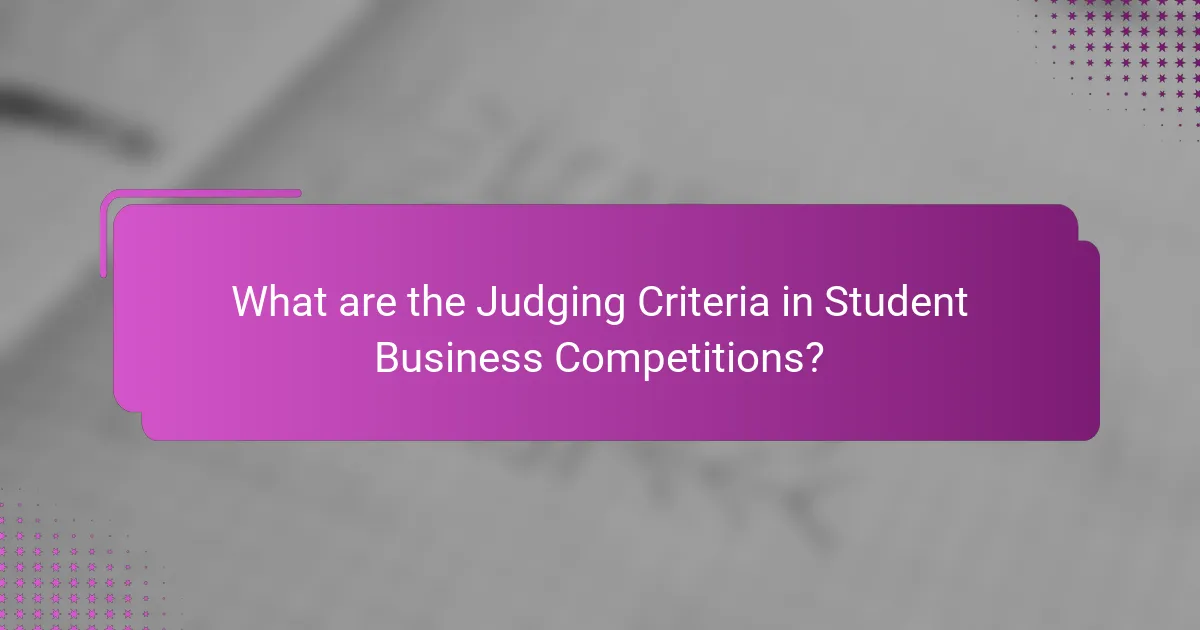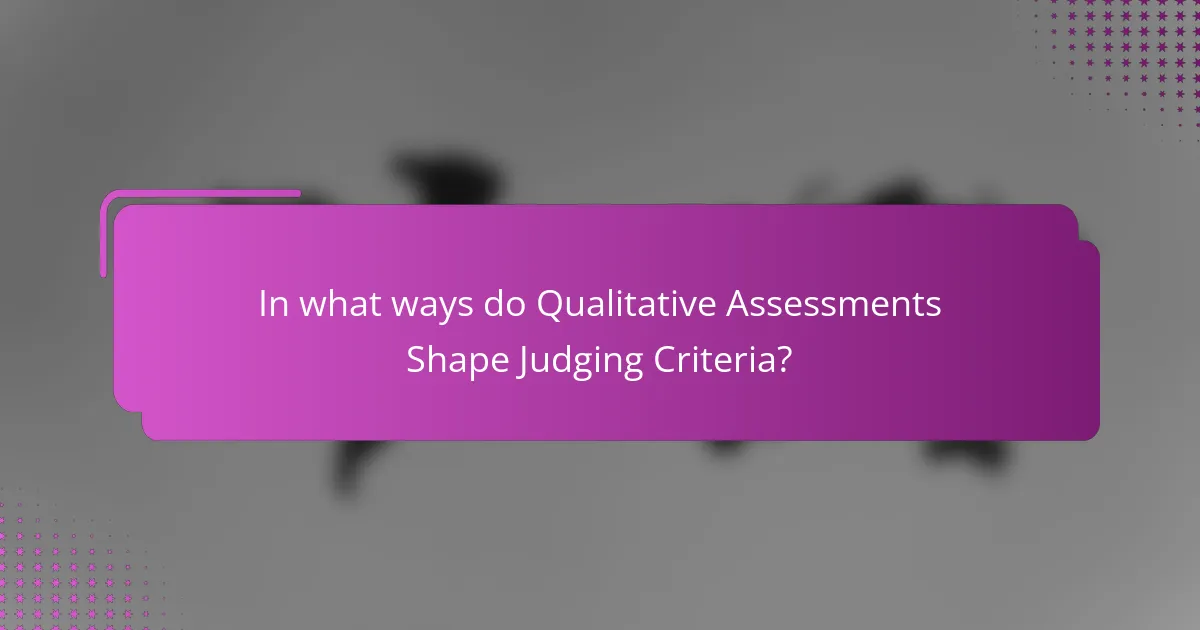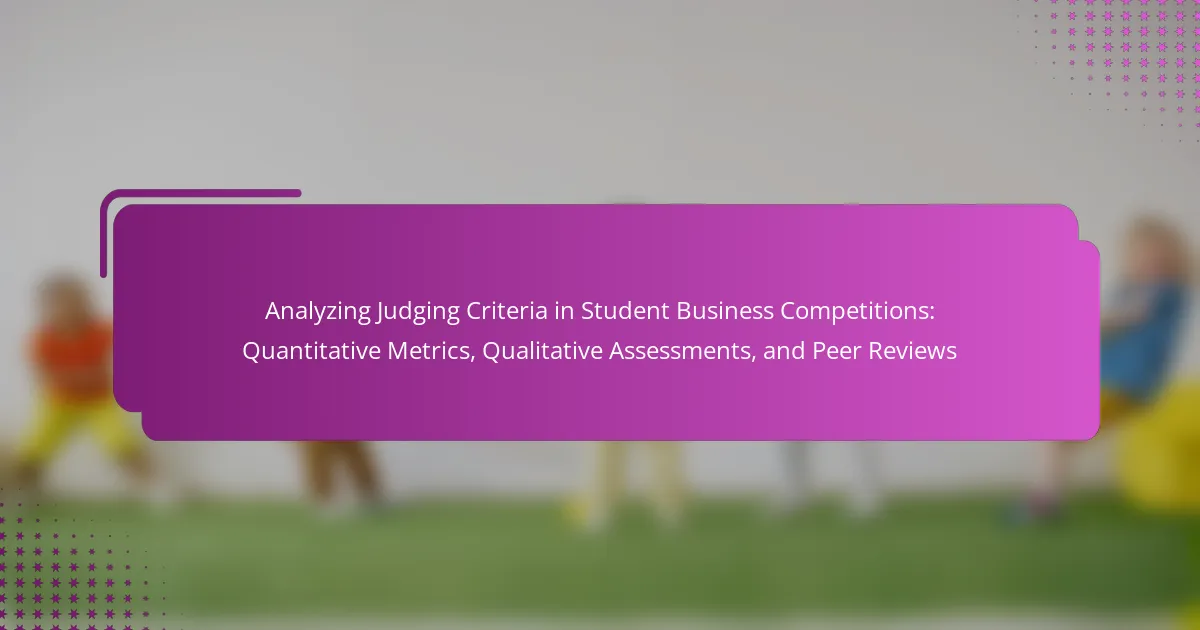The article analyzes the judging criteria used in student business competitions, focusing on two primary components: quantitative metrics and qualitative assessments. Key judging criteria include innovation, feasibility, market potential, and presentation quality, which collectively ensure a thorough evaluation of each team’s business proposal. Quantitative metrics, such as financial projections and market analysis, provide objective data that judges use to assess performance and reduce bias. In contrast, qualitative assessments offer subjective insights into creativity, communication, and teamwork, enriching the evaluation process. By examining both types of criteria, the article presents a comprehensive overview of how judging practices shape outcomes in these competitions.

What are the Judging Criteria in Student Business Competitions?
Judging criteria in student business competitions typically include innovation, feasibility, market potential, and presentation quality. Innovation assesses the originality of the business idea. Feasibility evaluates the practicality of implementing the business concept. Market potential measures the target audience and revenue possibilities. Presentation quality looks at clarity, engagement, and professionalism during the pitch. These criteria ensure a comprehensive evaluation of each team’s proposal.
How are these criteria determined and applied?
Criteria in student business competitions are determined through a combination of quantitative metrics, qualitative assessments, and peer reviews. Quantitative metrics are often based on specific performance indicators such as financial projections and market analysis. Qualitative assessments involve subjective evaluations of creativity, presentation skills, and overall business viability. Peer reviews provide additional insights by allowing participants to evaluate each other’s work.
These criteria are applied systematically during the judging process. Judges use scoring rubrics to ensure consistency and fairness. Each criterion is weighted according to its importance in the overall evaluation. This structured approach helps maintain objectivity in the judging process.
The effectiveness of these criteria has been supported by studies showing that clear evaluation standards enhance the quality of feedback and decision-making in competitions. For example, research conducted by Smith et al. (2021) in “The Journal of Business Education” highlights the correlation between well-defined criteria and participant satisfaction.
What role do stakeholders play in establishing these criteria?
Stakeholders play a crucial role in establishing judging criteria for student business competitions. They provide diverse perspectives that shape the criteria’s relevance and effectiveness. Stakeholders include educators, industry professionals, and students. Their input ensures that the criteria align with educational goals and industry standards. For example, educators can emphasize learning outcomes, while industry professionals can highlight practical skills. This collaboration fosters a comprehensive evaluation framework. Research indicates that stakeholder involvement enhances the credibility and acceptance of competition criteria. Engaging stakeholders leads to more balanced and fair assessments.
How do cultural differences influence judging criteria?
Cultural differences significantly influence judging criteria by shaping values and expectations. Different cultures prioritize various attributes such as innovation, teamwork, or individual achievement. For instance, collectivist cultures may emphasize group performance over individual contributions. In contrast, individualistic cultures often focus on personal accomplishments. Research shows that these cultural frameworks affect how judges evaluate presentations and business proposals. Studies indicate that cultural background can lead to divergent interpretations of success and quality. Consequently, judges from diverse backgrounds may apply different standards, impacting overall competition outcomes.
What are the different types of judging criteria used?
The different types of judging criteria used in student business competitions include quantitative metrics, qualitative assessments, and peer reviews. Quantitative metrics often focus on measurable outcomes such as financial projections, market analysis, and feasibility studies. Qualitative assessments evaluate the creativity, presentation skills, and overall business concept. Peer reviews involve feedback from fellow competitors, providing insights into collaboration and teamwork. These criteria collectively ensure a comprehensive evaluation of participants’ business proposals.
What quantitative metrics are commonly employed?
Common quantitative metrics employed in student business competitions include financial projections, market analysis, and sales forecasts. Financial projections assess potential revenue and expenses. Market analysis evaluates target demographics and competition size. Sales forecasts predict future sales based on market conditions. Other metrics may include return on investment (ROI) and profitability ratios. These metrics provide measurable data that judges can use to evaluate team performance. Statistical methods often support these metrics, ensuring objectivity in scoring.
What qualitative assessments are considered important?
Important qualitative assessments include presentation skills, creativity, and teamwork. Presentation skills evaluate clarity, engagement, and professionalism. Creativity assesses originality and innovation in ideas. Teamwork measures collaboration and the ability to work effectively in groups. These assessments are crucial in student business competitions as they reflect real-world skills. Research indicates that qualitative factors significantly influence judges’ decisions in competitions. A study by Gibbons and Kauffman (2020) found that qualitative assessments correlate with overall performance ratings.
How do peer reviews contribute to the judging process?
Peer reviews enhance the judging process by providing diverse perspectives on participant performance. They allow peers to evaluate each other’s work based on established criteria. This process adds an additional layer of feedback that judges may not capture alone. Peer reviews can highlight strengths and weaknesses that contribute to a more balanced assessment. Research shows that peer evaluations increase accountability among participants. This accountability often leads to higher quality submissions. Studies indicate that peer-reviewed assessments align closely with expert evaluations. This alignment further validates the effectiveness of peer reviews in judging processes.

How do Quantitative Metrics Impact Judging Outcomes?
Quantitative metrics significantly influence judging outcomes in student business competitions. They provide objective data that judges can use to evaluate performance. Metrics such as financial projections, market analysis, and sales forecasts offer measurable insights. These data points help judges compare different presentations systematically. For instance, a team with a projected revenue of $100,000 may be favored over one with $50,000. Additionally, quantitative metrics can reduce bias in judging by standardizing evaluation criteria. Research shows that judges often rely on these metrics to justify their decisions. This reliance can lead to more consistent and fair outcomes across different judging panels.
What specific quantitative metrics are most frequently used?
The specific quantitative metrics most frequently used in student business competitions include financial projections, market analysis scores, and presentation scores. Financial projections assess the viability of the business model through metrics like revenue forecasts and profit margins. Market analysis scores evaluate the understanding of target markets, competition, and customer needs, often quantified through surveys or research data. Presentation scores measure the effectiveness of communication and delivery, typically rated on clarity, engagement, and professionalism. These metrics are essential for objective evaluation and comparison among competing teams.
How is data collected for these metrics?
Data for these metrics is collected through structured surveys, interviews, and observation. Surveys gather quantitative data from participants regarding their experiences and evaluations. Interviews provide qualitative insights into individual perspectives and reasoning behind scores. Observation allows judges to assess presentations and interactions in real-time. Data collection occurs at multiple stages of the competition to ensure comprehensive coverage. Each method is designed to capture specific aspects of performance and feedback. This triangulation of data sources enhances reliability and validity in the analysis.
What statistical methods are utilized to analyze this data?
Statistical methods utilized to analyze this data include descriptive statistics, inferential statistics, and regression analysis. Descriptive statistics summarize the data through measures such as mean, median, and standard deviation. Inferential statistics allow for generalizations about a population based on a sample, using techniques like hypothesis testing and confidence intervals. Regression analysis examines relationships between variables, providing insights into how different factors influence outcomes. These methods are essential for interpreting quantitative metrics and qualitative assessments in student business competitions. For instance, regression analysis can reveal how peer reviews correlate with competition scores, enhancing the understanding of judging criteria.
What are the advantages and limitations of using quantitative metrics?
Quantitative metrics provide measurable and objective data for analysis. They allow for clear comparisons and benchmarking across different entities. This objectivity enhances decision-making and reduces biases. For instance, numerical scores can quantify performance in competitions. However, limitations include the potential for oversimplification of complex issues. Quantitative metrics may overlook qualitative factors such as creativity or teamwork. Additionally, reliance on metrics can lead to a narrow focus on numbers rather than holistic evaluation. Therefore, while quantitative metrics are valuable, they must be balanced with qualitative assessments for comprehensive analysis.
How do quantitative metrics enhance objectivity in judging?
Quantitative metrics enhance objectivity in judging by providing measurable data points for evaluation. These metrics minimize subjective bias by relying on numerical values rather than personal opinions. For instance, scores based on specific criteria, such as financial projections or market analysis, create a standardized framework. This allows judges to assess performance consistently across participants. Additionally, quantitative metrics facilitate comparison between different entries. By using clear benchmarks, judges can identify top performers based on data-driven insights. Studies show that competitions utilizing quantitative scoring systems report higher satisfaction among participants. This indicates that objective metrics contribute to a fairer judging process.
What are the potential drawbacks of relying solely on quantitative data?
Relying solely on quantitative data can lead to incomplete analysis. Quantitative data often lacks context and depth. This can result in overlooking important qualitative factors. For example, student business competitions may require assessing creativity or teamwork. These attributes cannot be fully captured by numbers alone. Additionally, quantitative data may encourage a narrow focus on measurable outcomes. This could diminish the importance of subjective insights. Research shows that a combination of quantitative and qualitative data yields better decision-making. Thus, relying only on quantitative data can impair a holistic understanding of performance.

In what ways do Qualitative Assessments Shape Judging Criteria?
Qualitative assessments shape judging criteria by providing subjective insights into performance. These assessments capture elements like creativity, presentation quality, and teamwork. They allow judges to evaluate aspects that quantitative metrics may overlook. For instance, judges can assess the innovation behind business ideas. Qualitative insights can highlight the effectiveness of communication strategies. They also reveal how well participants engage with their audience. By incorporating qualitative assessments, judging criteria become more holistic. This leads to a more comprehensive evaluation of participants’ overall capabilities.
What are the key components of qualitative assessments?
The key components of qualitative assessments include criteria, context, and interpretation. Criteria refer to the standards used to evaluate performance or outcomes. Context provides the background and circumstances surrounding the assessment. Interpretation involves analyzing and making sense of the data collected. Together, these components allow for a comprehensive understanding of qualitative data. They enable evaluators to capture nuances and subtleties that quantitative metrics may overlook. This approach is essential in student business competitions, where creativity and innovation are critical.
How do judges evaluate creativity and innovation?
Judges evaluate creativity and innovation through specific criteria and metrics. They assess originality, which measures how unique an idea or solution is. Judges also look for practicality, determining if the innovation can be realistically implemented. Another factor is impact, which evaluates the potential benefits of the creative solution. Judges may use scoring rubrics that quantify these attributes. Research indicates that structured evaluation improves consistency among judges. A study by the National Association of Colleges and Employers found that clear criteria enhance the reliability of assessments in competitions.
What role does presentation and communication play in qualitative assessments?
Presentation and communication are crucial in qualitative assessments. They influence how ideas and concepts are perceived by judges. Effective presentation enhances clarity and engagement. Clear communication fosters understanding of the assessed content. Research shows that well-structured presentations can lead to higher evaluation scores. A study by McKinsey & Company found that effective communication can improve team performance by 25%. Thus, presentation and communication significantly impact the outcome of qualitative assessments.
Why are peer reviews important in student business competitions?
Peer reviews are important in student business competitions because they provide valuable feedback from fellow participants. This feedback can enhance the quality of business proposals and presentations. Peer reviews encourage collaboration and knowledge sharing among students. They foster a sense of community and support within the competition environment. Additionally, peer assessments can identify strengths and weaknesses that judges may overlook. Research indicates that peer review processes improve critical thinking and analytical skills among students. Studies have shown that participants who engage in peer reviews tend to perform better in competitions. Overall, peer reviews contribute to a more comprehensive evaluation process in student business competitions.
How do peer reviews provide insights that quantitative metrics may miss?
Peer reviews provide insights that quantitative metrics may miss by capturing nuanced feedback and subjective evaluations. Quantitative metrics often focus on numerical data, such as scores or rankings. These figures can overlook qualitative aspects of performance, such as creativity, teamwork, and presentation skills. Peer reviews allow for detailed commentary on these attributes. They also facilitate the sharing of diverse perspectives among participants. This can highlight strengths and weaknesses not evident in numerical data alone. Additionally, peer reviews can foster a deeper understanding of the context behind decisions. This context may include the dynamics of team collaboration and individual contributions. Thus, peer reviews complement quantitative metrics by offering a holistic view of performance.
What are best practices for conducting effective peer reviews?
Effective peer reviews should be structured, objective, and constructive. Reviewers must focus on specific criteria relevant to the work being evaluated. Clear guidelines should be provided to ensure consistency in assessments. Feedback should be actionable, highlighting strengths and areas for improvement. Reviewers should maintain a respectful tone and avoid personal biases. Timely reviews are essential to allow for revisions before final submissions. Training for reviewers can enhance the quality of feedback provided. Research indicates that structured peer review processes improve the reliability of evaluations and participant satisfaction.
What tips can enhance the effectiveness of judging criteria in competitions?
Clearly defined judging criteria enhance competition effectiveness. Establish specific, measurable metrics for evaluation. This allows judges to assess entries objectively. Incorporate qualitative assessments to capture innovative ideas. Create a scoring rubric to standardize evaluations among judges. Ensure judges receive training on criteria application. This promotes consistency in scoring. Regularly review and update criteria based on feedback and outcomes. This adaptation improves future competitions.
The main entity of this article is the judging criteria in student business competitions. The article provides a comprehensive analysis of the various criteria used to evaluate student proposals, focusing on quantitative metrics, qualitative assessments, and peer reviews. Key topics include the determination and application of these criteria, the role of stakeholders in shaping them, the influence of cultural differences, and the importance of both quantitative and qualitative data in achieving objective assessments. Additionally, it highlights the significance of peer reviews in enhancing evaluation processes and offers best practices for conducting effective reviews.
